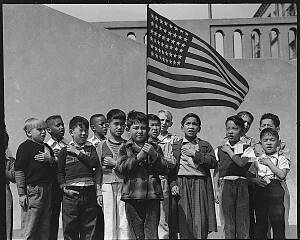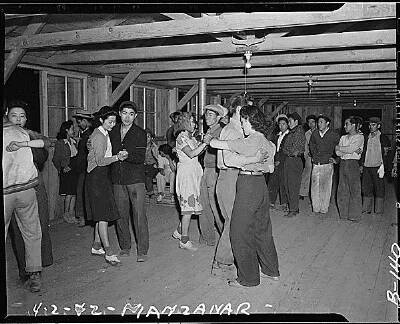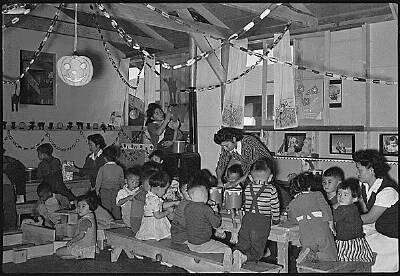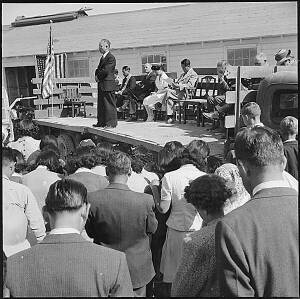WAR RELOCATION AUTHORITY
Community Analysis Section
Community Analysis Report No. 6
July 21, 1943
NISEI ASSIMILATION
Community Analysis Section
Community Analysis Report No. 6
July 21, 1943
NISEI ASSIMILATION
I. Are the Nisei Assimilated?
The old question as to whether the Oriental peoples are readily assimilable, or are not assimilable at all -- has been cropping up here and there lately, and seems largely to have gone unanswered. For this reason, the Community Analysis Section feels obligated to inform WRA staff members of facts bearing on the problem and to point out that so far as Japanese Americans are concerned, they have proven their assimilability by actually becoming as American in their thinking and in their behavior as have other second-generation immigrant groups, not ordinarily regarded as "unassimilable." Many people have accepted the "unassimilability" charge without question, having been influenced by a long tradition in American popular thought characterizing the Oriental as "mysterious" or "inscrutable" -- and by an unspoken assumption that a racial difference necessarily indicates deep, psychological differences. Actually, of course, the Issei differ in their mental sets from, say, people born and bred in Maine or Texas; but the differences derive from differences in culture, not from differences in race. Also, it is true, there are psychological differences which set the Nisei off from young people in the same age groups whose families have a long history, covering several generations, in this country.
Most of these last differences are also characteristic of second generation Americans of other racial stocks. They are derived from the minority group status of Japanese Americans and are comparable to the psychological peculiarities of all second generation immigrant groups whose parents migrated here as young adults, bringing with them the language and many of the customs of their homeland. So it is with such groups as the Italian Americans, Greek Americans, or Spanish Americans, that the Japanese Americans with their conflicts of two cultures, exposed to one at home and a second outside the home, must be compared. With them, as with other children of immigrants from foreign lands, the most serious kinds of conflicts with parents have arisen over such issues as the use of the foreign language at home, the degree of freedom and independence which should be allowed to young people, the conditions under which marriages should be contracted, the kinds of careers or the sorts of education which ought to be pursued. With them, just as with the other second generation groups, the pull of the majority, American culture has proven far the stronger, with the result that most Japanese Americans have grown up in the United States, have gone or are going through our school system and are thoroughly Americanized and exceedingly well assimilated.
The few thousand Kibei who have been sent to Japan for a part of their education because of their parents' desire to see them acquire a better appreciation of Japan are likely, if their period of Japanese education was long, to be considerably less American in their thinking and behavior than are other Japanese Americans. It must be remembered, however, that one of the reasons for the educational pilgrimage of some second generation Japanese to Japan has been the lack of Japanese schools -- except for the short session language schools -- in this country. Many other second generation groups have been privileged to attend special "nationality" schools in the United States. These have usually been parochial schools, but they have quite frequently served single nationality groups. In Burlington, Vermont, for example, there are separate elementary schools for Irish and for French-Canadian children, in addition to the public elementary schools. In the school for the French-Canadians, the first two hours are devoted either to the study of French, or to subjects taught in French (E. L. Anderson, We Americans, 1938, p. 114). Thus the tendency of some Japanese parents to seek a partly Japanese education for their children is closely paralleled by the
 similar
efforts of other immigrant
parents to utilize the schools as a means of imparting some of the old
country's values to their children, and need not indicate that the
Japanese and their children are any less willing to adopt American ways
than are many other immigrant groups. Rather, it is evidence of the
similar reactions of the Japanese and other groups to similar
situations. [PHOTO: "Flag of allegiance pledge at Raphael Weill Public
School, Geary and Buchanan Streets. Children in families of Japanese
ancestry were evacuated with their parents and will be housed for the
duration in War Relocation Authority centers where facilities will be
provided for them to continue their education." (San Francisco,
04/20/1942)]
similar
efforts of other immigrant
parents to utilize the schools as a means of imparting some of the old
country's values to their children, and need not indicate that the
Japanese and their children are any less willing to adopt American ways
than are many other immigrant groups. Rather, it is evidence of the
similar reactions of the Japanese and other groups to similar
situations. [PHOTO: "Flag of allegiance pledge at Raphael Weill Public
School, Geary and Buchanan Streets. Children in families of Japanese
ancestry were evacuated with their parents and will be housed for the
duration in War Relocation Authority centers where facilities will be
provided for them to continue their education." (San Francisco,
04/20/1942)]Assimilation may most easily be defined as the acquisition of the culture traits of a particular society by people of foreign origin or parentage. That Japanese Americans have gone far in their acquisition of American traits is obvious to all who have made comparative studies on the subject, but because the false impression that they are not well assimilated is so widely encountered, a brief review of some of the more important evidences of assimilation is given here.
II. Evidences of Assimilation
A. Material Culture and Manners
The Nisei dress in American clothes, eat American foods, buy American furniture, use American cooking and eating utensils, have permanent waves, live in American-style houses, and in every life activity utilize as a matter of custom and habit the appropriate American gadget rather than its Japanese type counterpart. Of course, the Nisei are likely to know more about the use of chopsticks or the proper method of wrapping a kimono sash than do other Americans -- just as Scotch Americans understand better the wearing of a highland costume or the significance of tartans. But for them, chopsticks and the kimono are unnatural, foreign objects, suitable enough for the old-fashioned Issei or for a costume affair, but wholly inappropriate for usage in daily life where American articles of clothing, American utensils, etc., are natural and comfortable. With food habits, the situation is much the same: the Nisei prefer American foods but quite naturally know more of Japanese foods than do New Englanders.
American manners are second nature to the Nisei. In greeting each other they shake hands and say "hello" and "how're you doing?" rather than going through the elaborate bowing ritual of Japanese greeting. Relations between Nisei of opposite sexes follow the informal American pattern -- much to the distress, be it said, of some of the Issei. While Nisei may be more likely to consult their parents regarding marriage than is the average American, they accept with little reservation the American conception that marriage is largely the business of the young people concerned, and marriages are frequently contracted despite parental objections. In many other ways, Nisei girls and women are emancipated, like their American contemporaries of other ancestry. All this is in sharp contrast to traditional Japanese custom.
Again, it is true that a Nisei can usually give a fair imitation of the Japanese forms of courtesy; but in doing so, most Nisei feel awkward and embarrassed, if only because they feel the forms to be foreignisms and because they well know that their imitation is shamefully imperfect in the eyes of their parents.
The recreational activities of Nisei are also characteristically American. Even in the relocation centers, where segregation from the wider American society and enforced close association with the Issei and Kibei have tended to slow down the processes of assimilation, this is conspicuously evident. The two most popular sports in the centers are baseball and basketball, with ping-pong, volley ball, and (in season) football also very popular. Not only do the Nisei play these American games but they play them skillfully, hundreds of them having achieved prominence as members of high school athletic teams prior to evacuation.

Baseball game, Manzanar, 1943 (Ansel Adams)
Young Nisei, especially the girls, belong to social clubs, modeled exactly after those of other teenaged Americans, which give teas, organize dances, help out in the Red Cross drives and perform other social services. Many Nisei are members of the YWCA or YMCA, and some have become outstanding Y workers.
A favorite recreation for younger Nisei is dancing, and the dances are the same as those popular among all young Americans. Danced to the same music, they follow American conventions, including the types of refreshments, styles of hall decoration, and shyness between girls and boys. Even so typically an American trait as jitterbugging is to be found among the Nisei -- a trait which represents a conspicuous break with the Japanese tradition of reserved and decorous behavior.

"Dancing for recreation in the early days at Manzanar reception center." (04/02/1942)
The listing of American material traits and manners which have become the Nisei's own could be indefinitely extended, always leading to the same inevitable conclusion. As one authority put it prior to evacuation, "....the typical behavior of the second generation Japanese Americans is clearly much more characteristic of American culture than it is of Japanese culture. Beyond a doubt, if present tendencies continue, the Japanese will continue to become increasingly American until they achieve complete acculturation....." 1/ (Evacuation of course, represents a discontinuance of pre-evacuation tendencies, but resettlement allows for their resumption.)
B. Language
The language of the Nisei is English. In spite of persistent efforts on the part of the Issei to encourage the learning of Japanese through special language schools, or through the use of Japanese at home, very few Nisei have any real proficiency in Japanese. 2/ Those who do know Japanese are likely to have spent some time in Japan or to have grown up in the more isolated rural regions of California. Even most of the latter have a better command of English than of Japanese.
The continuing use of Japanese by many Issei is not a sign of Oriental unassimilability but also characterizes first generation immigrant groups of European origin. A recent study of language use in the homes of a group of American-born high school boys of Italian origin in New York led to the following conclusions:
"1. Two distinct languages are still used in Italian homes: the parents use Italian, and the boys use English.Except for No. 2, which is obviously irrelevant to Japanese Americans, these comments become a good description of the language situation in Japanese and Japanese American homes in the United States, if the word 'Japanese' be substituted for 'Italian' throughout. The special significance of this illustration is that neither race nor Oriental origin are of any special importance in the production of the partially bilingual home; on the contrary, it is the consequence of the living together of two generations, the first of which possesses facility in a foreign language, while the second is much more at home in English.
"2. The 593 boys who had chosen Italian as their foreign language in high school used that language with their parents and grandparents.
"3. The language of exchange in the home is still Italian or an Italian dialect. The boy may speak English because he lacks facility in Italian or in the dialect of his family, but the older folk answer in Italian or in the dialect.
"4. The parents speak to each other in their own language. Only 9 percent of them speak English exclusively." 3/
Direct evidence of the prevalence of English usage among the Nisei is seen in the fact that most Japanese language dailies in the United States have added an English language page in an effort to reach the Nisei (who were inaccessible through Japanese) by 1932. Most Nisei associations conduct their meetings in English, the language is used naturally and as a matter of course among school children throughout the grades and in high school (although some children from "Japanesey" homes tend to prefer Japanese at the nursery school or kindergarten level). In short, the Nisei use English quite as naturally as do other Americans, and very nearly all of them feel uncomfortable when compelled to communicate in Japanese, largely because they can speak it only haltingly. (It must be pointed out that one of the effects of relocation center life has been to lead to an increase in the use of Japanese by some Nisei; nevertheless, the above statements are quite accurate as applied to the pre-evacuation situation and need not as yet be much discounted as applied to relocation centers.)

Kindergarten class in Canal. (Gila River, 1943)
C. Religion
When the Issei first arrived in the United States, they were, with a few exceptions, non-Christian in religion, and even today, over two-thirds of them are Buddhists. In contrast, less than half of the Nisei are Buddhists, and 35 percent of them (as against 22 percent of their parents) are Christians, largely Protestant. Perhaps even more significant is the large proportion of Nisei who profess no particular religion: over 16 percent of the Nisei in relocation centers declined, as of November, 1942, to identify themselves with any religious group. 4/ Thus, the Nisei are seen to have gone far in the direction of taking over the religious practices prevalent in the United States, even including, apparently, a fair amount of agnosticism. This contrast between the Nisei and Issei is of especial importance as an evidence of assimilation, for, as is well known to social scientists, the taking over of a new material culture is relatively easy, but the abandonment of a traditional religion in favor of a new one is very difficult -- except for people who have come to identify themselves much more thoroughly with the new culture than with the old.
However, although nearly half of the Nisei remain Buddhists, they are not by that token, unassimilated. Buddhism among the Japanese and their children in American has itself become Americanized in important respects. Buddhist churches have taken over the Sunday School-Young Peoples' Club complex typical of American Protestantism. Many of them, in an effort to hold Nisei members, use English in part of their services or conduct some services in English. Representatives of the Young Buddhists Association from relocation centers who recently met at Salt Lake City, decided to establish a national headquarters, separate from the Hongwanji Mission, as a purely American
 religious
organization. Buddhist churches in relocation centers organized their
activities along lines quite like those followed by the Christian
groups. An interesting example is the Buddhist observation of Father's
Day at Jerome. There is no basis, then, for the supposition that
Buddhist Nisei are ill-assimilated. On the average the
Christians
may be better assimilated, but very many of the young Buddhist Nisei
are well assimilated, also, and are members of a church which, though
bearing a foreign name, is in fact much closer to American religious
traditions than to those of Japan in many significant ways. [PHOTO:
"With a fervent prayer, this Japanese Topaz resident, a Christian
Minister, opens the dedication ceremonies at the Relocation Center at
Topaz." (10/17/1942)]
religious
organization. Buddhist churches in relocation centers organized their
activities along lines quite like those followed by the Christian
groups. An interesting example is the Buddhist observation of Father's
Day at Jerome. There is no basis, then, for the supposition that
Buddhist Nisei are ill-assimilated. On the average the
Christians
may be better assimilated, but very many of the young Buddhist Nisei
are well assimilated, also, and are members of a church which, though
bearing a foreign name, is in fact much closer to American religious
traditions than to those of Japan in many significant ways. [PHOTO:
"With a fervent prayer, this Japanese Topaz resident, a Christian
Minister, opens the dedication ceremonies at the Relocation Center at
Topaz." (10/17/1942)]D. Ideals and Ambitions
The most telling evidence of Nisei assimilation is the extent to which they have accepted as their own American ideals and standards of success. Their adoption of Christianity and the Americanizing of Buddhism are illustrations of the Nisei acceptance of American values, and there are many more. American standards of success, and ideas of desirable occupations are a part of the Nisei value system. Born of parents whose tradition is one of fixed classes, with sons' and daughters' social status defined by the class of the parents, the Nisei have struggled valiantly to move upward in the relatively open class system of America. To this end they have sought education, especially on the secondary and college level, as a means to improved status. Census figures for 1940 show this clearly. The Nisei population of the four West Coast states 25 years of age and older is conspicuously better educated than is the native-born white population of the country at large. In terms of years of school completed, there is relatively little difference for grade school, although approximately 93 percent of the Japanese Americans as compared to 83 percent of the native whites have completed the 7th grade. But 57 percent of the Nisei have completed 4 years of high school as compared to only 29 percent of the native white group. More Nisei relatively have completed 4 years of more of college, too, although here the contrast is less, the figure for Nisei being 7 percent, and for the native white population 5 percent. 5/ Impressive as these figures are, the differential indicated would be even more striking if comparisons were made according to the occupations of the parental groups, since as is well known, the native whites whose children carry their education farthest are those whose occupational status is higher than that of the average Issei.
In connection with the Nisei drive for education, one of the most important grounds for contending that their assimilation has been as thorough-going as that of most children of immigrants may be mentioned. The pattern of school achievement for immigrant's children is often one of relatively poor performance. In a general discussion of "The School and the Immigrant", (in Brown and Roucek, Our Racial and National Minorities, p. 605-606), E. George Payne develops the thesis that elementary and secondary school programs are not at all well adjusted to the needs of immigrant children, and that this is the explanation of the fact that, as in Bridgeport, Connecticut, children of immigrants fail much more frequently than do those of native-born parents. In contrast, the Japanese Americans on the Pacific Coast have performed at least as well and quite often better in school than have their classmates. 6/ In a Seattle high school, for example, they have nearly three times as many high school valedictorians and honor students as their percentage in the school population would indicate (J.F. Steiner, Behind the Japanese Mask, p. 61); there is evidence, too, that Japanese American "membership in honorary fraternities is disproportionately higher than that of any other group" (R. W. O'Brien, "Student Relocation", Common Ground, Summer 1943, p. 74).
The Nisei, then, not only attend American schools in disproportionately large numbers, but are unusually successful in their scholastic achievement -- all of which is evidence of a high degree of assimilation.
Nisei adherence to democratic political ideals is general, as was demonstrated clearly in the recent registration, when in spite of the most adverse circumstances, /_see various Community Analysis reports on registration_/ 79.1 percent of the Nisei registered expressed their willingness to swear unqualified allegiance to the United States.
III. Conclusion
Significant evidence of the high degree of Nisei assimilation of American ways, comparing favorably with the attainments of other groups of immigrants' children, has been briefly reviewed. It is necessary to add two qualifications at this point. First, there is considerable variation in the extent to which individual Nisei are typically American in personality. In general, those who have grown up in rural areas, in relative isolation from the main currents of American life, are less thoroughly Americanized than those reared in urban situations which constantly have brought them into contact with the wider American society. Those who have carried their education further are likely to be more completely assimilated. Second, even the most thoroughly assimilated are to some extent influenced by their parents' culture; but usually by facets of it which correspond with American patterns -- as in respect for law, or for education. (It is important to note that similar qualifications must be made regarding the Americanization of other second generation groups.)
To summarize, then, the Nisei as a group are American in their dress, in their eating, in their manners, in their recreational preferences, in their ambitions, in their religious tendencies, in their language, and -- crucially -- in their ways of thinking, their ideals and values. Although life in relocation centers is impeding the further assimilation of many Nisei, and is even driving some back toward the culture of their parents, most of them today are as thoroughly American as the average immigrant's child.
1/ J.A. Rademaker, "Japanese Americans", in Brown and Roucek, Our Racial and National Minorities, p. 489.
2/ In the same way, the Russian Molokans in Los Angeles sought -- unsuccessfully -- to perpetuate the use of Russian in the second generation. So also the Norwegians established Norwegian language schools in the prairies. Thus late afternoon "language schools" are scarcely an exclusive Japanese trait. See, for instance, P.V. Young, The Pilgrims of Russian Town, pp. 114 n. and 269.
3/ From the chapter on "Language and Social Adjustment", in Our Racial and National Minorities, pp. 694-695.
4/ Figures supplied by the Relocation Planning Division.
5/ Based on a chart prepared by the WCCA.
6/ See Reginald Bell, Public School Education of Second Generation Japanese in California, 1935, especially pp. 407-433.
-- Table of
Contents --